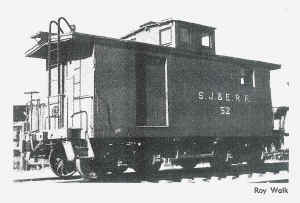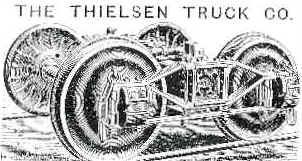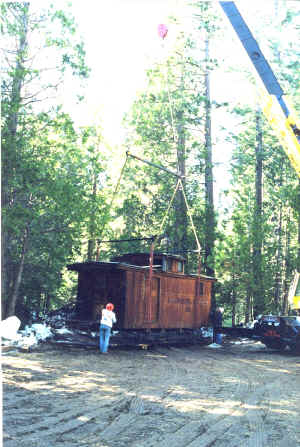| RyPN Briefs March 1, 2005 |
|
|
SJ&E Caboose Restorations
The San Joaquin & Eastern (SJ&E) Railroad connected to the Southern Pacific (SP) north of Fresno, California and wound its way 56 miles up into the central Sierra Nevada, terminating at Big Creek (formerly Cascada), California. The railroad, constructed in 157 days during 1912, was built primarily to haul equipment, supplies and workers for the Southern California Edison (SCE) Company, in the latterís efforts to build a number of hydroelectric power houses, dams and lakes to store water, and penstocks to transport the water to the power houses.
In addition to the railroad itself, a branch line was built to the Shaver Lake area, and several inclines were constructed to install penstocks and build dams. The SJ&E also serviced what was to become Huntington Lake and Shaver Lake, by hauling logs out of the future lake basins, servicing the lumber mills, providing lumber for the various construction sites, and hauling rock and gravel for the dams.
The marvelous history of the SJ&E is recorded in Hank Johnstonís book "The Railroad That Lighted Southern California" (available from Stauffer Publishing).
 |
| In service photo of SJ&E caboose No. 52, currently residing behind a house near Clovis, California, sans trucks and couplers. Photo used courtesy of Stauffer Publishing. |
The SJ&E ceased operating in 1933 and was torn up for scrap within the next several years. All that survived was one engine, an observation car and three cabooses (numbers 50-52).
The cabooses were either sold, or given, to three ranching families residing along the old right-of-way. The trucks, couplers and other items were either sold for scrap, or taken by souvenir hunters, at that time. The cabooses then sat idle in pastures, or in the case of No. 52 behind a house, for over 70 years.
Recently two of the cabooses, No. 50 and No. 51, were donated by their former owners to the Central Sierra Historical Society (CSHS) in Shaver Lake, and the Eastern Fresno County Historical Society (EFCHS), respectively. Two elderly sisters, whose father worked on the SJ&E, still own No. 52, which sits behind their house northeast of Clovis, California (just northeast of Fresno). They refuse to allow anyone to see the caboose, or to discuss donating or selling it.
There are three schools of thought on how the cabooses came to the SJ&E. Hank Johnston's book states that the 26' wooden cabooses were purchased from the SP in 1912. The Curator of History and Technology at the California State Railroad Museum believes they may have been SP box cars, or flat cars, converted by the SJ&E shop crew to cabooses. The Restoration Specialist at the Nevada State Railroad Museum thinks it possible neither of the above theories is true, and that in fact the cabooses were "scratch built" by the SJ&E. Photos from 1913 show numbers 50 and 52 in a consist without cupolas, with off center sliding doors located opposite from where the cupolas would be installed later.
The restorations of No. 50, stored at the CSHS site in Shaver lake, and No. 51, stored at the EFCHS site about 15 miles away, are now in the initial phases. Neither No. 50 or No. 51 (nor No. 52) have trucks or couplers. Restoring the two cabooses will require obtaining four sets of standard gauge short 20-ton arch bar trucks, circa 1890, and size "D" couplers of that era.
 |
| Scanned image of what are thought to be appropriate trucks for the cabooses. |
Persons with knowledge of the possible whereabouts of trucks and couplers as described, or suitably accurate
facsimiles, are encouraged to contact the
author (who is the team leader for the CSHS restoration effort) at (559) 298-3094, or via email at
gscale@qnis.net. The CSHS is
also attempting to assist the EFCHS in obtaining suitable replacements for their
restoration of No. 51.
Any help that can be offered is greatly appreciated.
(Brooks Wilson)
